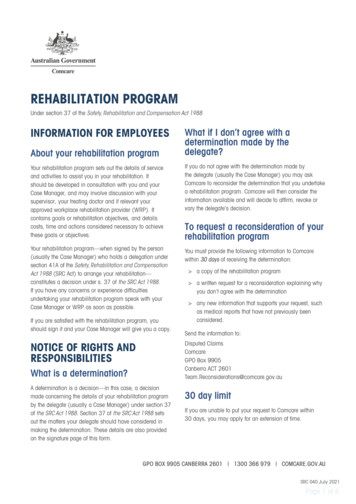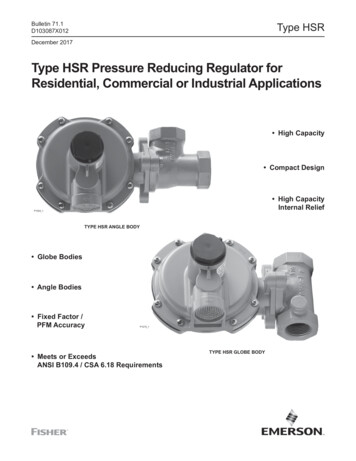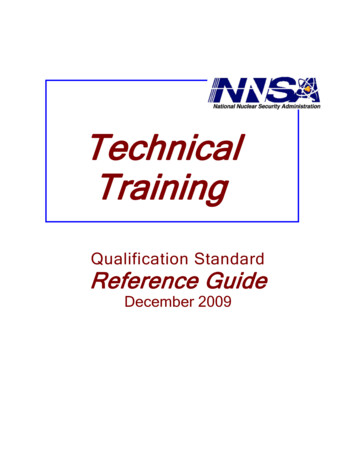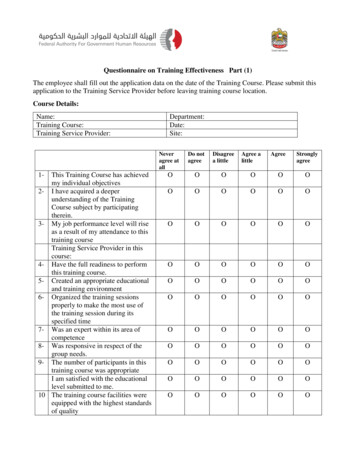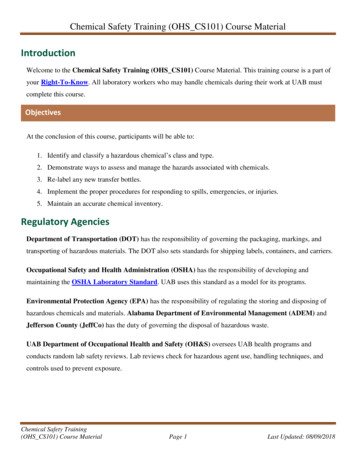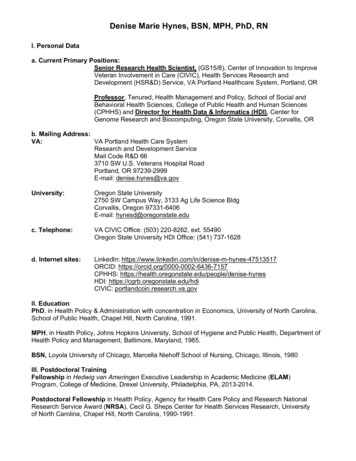
Transcription
HSR TRAINING COURSEREQUIREMENTSGuidance 2December 2017
CONTENTSHSR TRAINING COURSE REQUIREMENTS FOR THE COMMONWEALTH JURISDICTION4Introduction4Learning resources4PART 1—UNDERPINNING PRINCIPLES FOR THE DEVELOPMENT OF A COMCARE-APPROVEDHSR TRAINING COURSE41.1 Background information41.2 Agreed approach to training51.3 Delivery mode61.4 Course duration7PART 2—LEARNING OUTCOMES FOR HSR TRAINING COURSES72.1 Initial five day course72.2 One day refresher courses7PART 3—LEARNING OBJECTIVES—INITIAL TRAININGHSR TRAINING COURSE REQUIREMENTS—GUIDANCE 28 3
HSR TRAINING COURSE REQUIREMENTS FOR THECOMMONWEALTH JURISDICTIONINTRODUCTIONHealth and Safety Representative (HSR) training should provide guidance on the powers and functions of HSRs as provided in theWork Health and Safety Act 2011 (WHS Act) and Work Health and Safety Regulations 2011.Safe Work Australia and Comcare have developed guidance material to assist those interested in becoming an approved HSRtraining provider. How to become an approved provider of Health and Safety Representative training for the Commonwealth jurisdiction—Guidance 1 HSR training course requirements—Guidance 2. This guide consists of:–underpinning principles for the development of a Comcare-approved HSR training course–learning outcomes for the initial five day course, and,–requirements for the one day refresher course.LEARNING RESOURCESTo ensure consistency across all jurisdictions, additional resources for training providers are available to assist with developingand delivering HSR training.Resources are available on the Safe Work Australia and Comcare /www.comcare.gov.auPART 1—UNDERPINNING PRINCIPLES FOR THEDEVELOPMENT OF A COMCARE-APPROVED HSRTRAINING COURSE1.1 BACKGROUND INFORMATIONOne of the aims of introducing model WHS legislation in 2012 was to ensure work health and safety regulation consistencyacross jurisdictions, including workplace consultation, representation and participation arrangements.Part 5 of the WHS Act outlines the workplace consultative arrangements between a person conducting a business or undertaking(PCBU) and workers. These arrangements are designed to encourage consultation, representation and participation to jointlymonitor WHS issues and improve WHS standards. These mechanisms include: the formation of work groups and health and safety committees the election of HSRs with a range of rights and powers duties on PCBUs to consult with HSRs on WHS issues in certain circumstances.4 HSR TRAINING COURSE REQUIREMENTS—GUIDANCE 2
Under the WHS Act, a PCBU has the duty to consult and ensure workers are involved in decisions on WHS. Workers should alsobe consulted on proposed changes to the workplace that may affect the WHS of anyone in a work group. The formation of workgroups and the election of HSRs are intended to facilitate worker representation, discussion of WHS matters, and identificationand control of risks. Importantly: HSRs play a key role in prevention of workplace injury and illness, and promotion of good WHS practice WHS legislation does not impose specific obligations on HSRs but provides HSRs with powers and functions there are no pre-requisites for becoming a HSR, other than to be an elected member of the work group.1.2 AGREED APPROACH TO TRAININGHSR training is not a mandatory requirement under the WHS Act. However, if a HSR requests training, a PCBU must allow this tooccur. A HSR has the right to attend an approved HSR training course of their choice in consultation with their PCBU.HSRs are not able to exercise all their powers—issuing PINs, and cessation of work—if they have not completed an approvedcourse of training.To ensure an effective and consistent approach to development and delivery of HSR training across jurisdictions, all harmonisedWHS regulators have identified and adopted the following underpinning principles.1.2.1 HSR training does not include a formal assessmentThe intent of training is to develop a HSR’s skills so they can represent their work group and exercise their powers and functionsunder the WHS Act. The HSR training course is not intended to train HSRs to be health and safety professionals or fulfil a PCBU’sWHS obligations.Following participation in a course approved under the WHS Act, a HSR may wish to pursue more formalised training or seekrecognition of prior learning (RPL) leading to a vocational qualification.1.2.2 Adult learning principlesAdults learn in different ways and bring a range of experiences and backgrounds to the learning environment. The HSR trainingcourse content and activities should integrate this experience and diversity, and provide HSRs with the skills and knowledge torepresent their work groups effectively.Training delivery should provide participants with opportunities to contribute and reflect upon their own workplace experience.1.2.3 ContextThe majority of adults like to see the relevance of what they are learning to their work and life. Course content should enableparticipants to understand the link with their workplace experience or situation. Activities should allow time for each participant torelate their skills and knowledge to industry specific WHS issues.HSR TRAINING COURSE REQUIREMENTS—GUIDANCE 2 5
1.2.4 InclusiveThe following factors should be considered when developing and delivering HSR training courses: age gender culture disability language literacy numeracy.The principles of plain English and gender neutral language should also be adopted in the training materials and training deliveryto ensure participants feel comfortable, confident and safe to interact with one another and participate fully in training activities.1.2.5 Activity-basedThe majority of adults are more likely to learn when they are actively involved rather than passively sitting and listening to atrainer presenting information. A range of interactive activities (such as group work, case studies and workplace inspections)should be used so participants can further develop and practice the required knowledge and skills. Participants should beencouraged to actively engage with other participants to develop consultation skills and the ability to cooperate and coordinatewith other people in their role.1.2.6 Accommodates differences in learning stylesThe course content should cater for differences in learning styles or special needs. Using a variety of media (e.g. print, digital,audio) and activities (e.g. trivia quizzes, games, role plays) should ensure all learning styles are accommodated.1.2.7 Learner-centredA learner-centred approach to training focuses on the achievements of the participant, rather than the intentions of the trainer.Participants should be encouraged to engage with other HSRs and share their perspectives and experiences. They should also beprovided with opportunities for self reflection.1.2.8 Commitment to safetyThe safety and welfare of participants must be considered when training content and activities are developed and delivered.Applicants must ensure that they meet all WHS legislative requirements and commit to providing a safe and positive learningenvironment. Participants should be encouraged to interact, question and challenge in a non-judgemental environment.1.3 DELIVERY MODETraining should be delivered in a way which maximises participation and engagement. To achieve this training must be delivered‘face-to-face’ so HSRs can interact and learn from each other. ‘Face-to-face’ mode of training delivery is defined as participantsbeing in the same physical location, i.e. in the same room, at the same time.6 HSR TRAINING COURSE REQUIREMENTS—GUIDANCE 2
1.4 COURSE DURATION1.4.1 Initial training (5 days)Training can be delivered over five consecutive days, or spread over a longer period of time with training delivered in ‘blocks’ oftime no less than one day in duration. The course should be conducted as seven hour days, excluding breaks—35 hours overthe five days. It is suggested that one hour of breaks should be spread throughout the day.Providers must ensure that all participants commence and complete their initial 5 days training within a 6 month period to beeligible to obtain a certificate of attendance and to have the full powers of a trained HSR.1.4.2 Refresher training (1 day)Refresher training must be a minimum of seven hours face-to-face training over a period of one day.PART 2—LEARNING OUTCOMES FOR HSR TRAININGCOURSES2.1 INITIAL FIVE DAY COURSEThis part of the document covers the agreed learning outcomes for an initial five day course of training for HSRs. The learningoutcomes should be read with the underpinning principles in the previous part of the document, as both aspects provide thecontext for designing and writing the course content.The learning outcomes have been grouped under several learning objectives. These objectives represent the knowledge and skillsthat would support elected HSRs to fulfil their role, perform their functions and exercise their powers.The learning objectives are presented in no particular order and are not intended to suggest a sequence of course delivery orcontent. The course content should be written with a holistic and integrated approach so participants are exposed to a range ofcomplementary learning methods and activities.The HSR is an elected, voluntary role. The initial five day course is not intended to make HSRs qualified or expert WHS specialists,but rather provide them with support, knowledge and skills so that they can represent their work group in WHS matters.The expected learner application for each learning outcome provides guidance on inclusions such as activities, case studies,discussions and skills practice sessions. The learner applications specify what a HSR could be reasonably expected to do orknow at the conclusion of the initial five days of training.2.2 ONE DAY REFRESHER COURSESFollowing completion of an initial five day course, a HSR is entitled to attend one day refresher training annually.Refresher Courses are assessed against the basic requirements outlined in our guidance stating they should(a) provide HSRs with an overview of the Learning Outcomes in the initial five day training;(b) provide the HSRs with information on any developments in WHS legislation, such as changes to the Act, Regulations,Approved Codes of Practice or any updated case law; and ,(c) focus on HSR skills development.Providers have an opportunity to be creative with the design and information presented in the refresher courses to maximise HSRengagement and are encouraged to discuss different options with the HSR Course Approvals Team.HSR TRAINING COURSE REQUIREMENTS—GUIDANCE 2 7
PART 3—LEARNING OBJECTIVES—INITIALTRAININGThe following section outlines and describes the six broad learning objectives, the associated learning outcomes for each,and the expected learner application required. Where appropriate particular activities have been mandated and are highlightedin bold.The matrix required with your application should demonstrate that your course addresses each of these elements and shouldfollow the same sequencing numbering system.LEARNING OBJECTIVE A—INTERPRETING THE WORK HEALTH ANDSAFETY LEGISLATIVE FRAMEWORK AND ITS RELATIONSHIP TOTHE HSRDescription:Information about the historical antecedents that have informed and shaped current WHS principles and legislation will give HSRsan understanding of the legislative context and purpose of their function. HSRs need to understand the legislation—and otherlegislative framework components—to explain how and why they have referenced the legislation when exercising their powers.On completion of an approved training course, HSRs should be able to confidently interpret the WHS legislative framework and itsrelationship to their role and powers.Learning outcomeExpected learner applicationA1Understand thecontext of WHSlegislation andpracticeA1(a)A1(b)A1(c)A2Understand theobjects andprinciples of theWHS ActA2(a)A2(b)A2(c)A2(d)A3Identify variouselements ofthe legislativeframeworkA3(a)A3(b)A3(c)A4Understand therole and functionsof (the regulator)and theirinteraction withHSRs8 A4(a)A4(b)A4(c)A4(d)Key legislativeprovisionsDiscuss key concepts in the evolution of WHS within Australiaincluding the careless worker theory, the influence of the Roben’sReport (UK), relevant (jurisdictional based) legislative reviews andWHS harmonisation within AustraliaIdentify some key impacts—social and economic— arising fromworkplace injury and illnessIdentify data on workplace injuries, illness and incidents relevant totheir work group and industry sectorBackgroundknowledge andcontextIdentify the key objects and principle/s of the WHS Act and thesignificance of these to WHSExplain key concepts underpinning the principles that apply to allduties persons have under the WHS ActIdentify and use key terms contained within the WHS Act relating totheir role and workplaceDraw links between the role of the HSR and the WHS Act objectivesWHS Act sections3–9, 13–17Identify WHS legislation, codes of practice, relevant industry/Australianstandards, regulator specific guidance materials/interpretive guidelines,and explain their legal status, purpose and relation to each otherExplain using the WHS legislation, approved codes and guidancematerial, key sections of relevance for their industry sector/workplaceExplain the links between WHS, workers’ compensation andrehabilitation of injured workersWHS Act sections274 and 275Provide examples of regulator functions and powers and how these areused to facilitate compliance with WHS legislationExplain how to access the support services and resources for HSRsprovided by the regulatorOutline the role of an Inspector and how they can assist HSRsIdentify when a HSR may have contact with or seek assistance from anInspectorWHS Act sections82 and 160HSR TRAINING COURSE REQUIREMENTS—GUIDANCE 2
Learning outcomeExpected learner applicationA5Understandthe safe workapproach to workhealth and safetyissuesA5(a)A5(b)Key legislativeprovisionsUsing workplace scenario/s, explain why a ’safe work’ approachshould be taken by a PCBU, rather than focusing on a ’safe person’approach when resolving WHS issuesIdentify the range of factors that would contribute to making aworkplace a safe environmentBackgroundLEARNING OBJECTIVE B—IDENTIFYING KEY PARTIES, LEGISLATIVEOBLIGATIONS AND DUTIESDescription:HSRs should be able to identify key duty holders and their duties when representing the work group in relation to WHS. HSRs willbe able to identify the legislative penalties of the main duty holders for not meeting their obligations under the WHS Act.On completion of an approved training course, HSRs should be able to confidently interpret the WHS legislative framework and itsrelationship to their role and powers.Learning outcomeExpected learner applicationB1Summarisethe duties andresponsibilities ofPCBUs under thelegislationB1(a)B1(b)B1(c)B1(d)B1(e)B2Identify theduties andresponsibilities ofofficers, workersand other partiesB2(a)B2(b)B2(c)B2(d)B3Identify anddiscuss the rangeof enforcementoptionsB3(a)B3(b)B3(c)Key legislativeprovisionsExplain and use the term PCBU in the context of their roleIdentify PCBUs of relevance to the HSR’s work group and workplaceand summarise their duties, with reference to the appropriate sectionsof the WHS Act as relevantDiscuss what is meant by ‘reasonably practicable’Discuss what is meant by ’risk management’ using examples toexplore measures in the hierarchy of controlDiscuss the duties and responsibilities of PCBUs under the WHSlegislation including the management of risks to the health and safetyof workers and other persons at the workplaceWHS Act sections18–29Compare the duties and responsibilities of an ‘officer’ and those of thePCBU, as these relate to the workplaceExplain what is meant by ‘due diligence’ in connection with the dutiesof an officerExplain the duties of workers in relation to health and safety at theworkplaceIdentify officers, workers and other parties within the work group/workplace who would have a duty, as defined under the WHS ActWHS Act sections4, 13–21, 27–29Describe the range of enforcement options available to the regulator forkey duty holders for non-compliance with the WHS legislationIdentify the relevant offences and penalties under the frameworkIdentify practical examples of the consequences that apply to key dutyholders for not complying with the WHS legislationWHS Act sections30–34WHS ActParts 10 and 11HSR TRAINING COURSE REQUIREMENTS—GUIDANCE 2 9
LEARNING OBJECTIVE C—ESTABLISHING REPRESENTATION INTHE WORKPLACEDescription:HSRs should have an understanding of their role, powers and protections under the legislation and have the skills to use theirpowers appropriately to achieve representation of workers and improve safety outcomes. HSRs should be able to use therepresentative process outlined in the WHS Act and know where to access various support mechanisms.On completion of an approved training course, HSRs should be able to confidently interpret the WHS legislative framework and itsrelationship to their role and powers.Key legislativeprovisionsLearning outcomeExpected learner applicationC1C1(a) Define a work group and describe its purposeC1(b) Identify the responsibilities of the PCBU in formation of work groupsC1(c) Identify the matters that need to be taken into account when workgroups are formedC1(d) Identify and explain the circumstances under which existing workgroups could change, resulting in fresh negotiations to form new workgroups in the workplaceC1(e) Identify the range of options available to the parties involved, ifnegotiations regarding the establishment of a work group failC1(f) Explain issues with the establishment of multiple work groups, possibleimpacts on the negotiation of work groups (if relevant) and how a HSRshould represent multiple workgroupsWHS Act sections50–59C2Understandthe electionprocess for HSRs/Deputy HSRs anddisqualificationprovisionsC2(a) Explain the election processes and roles/obligations of relevant partiesin the processC2(b) Identify the term of office for a HSR or Deputy HSRC2(c) Identify circumstances that would result in a HSR no longer being ableto represent their work group or hold officeC2(d) Describe the disqualification provisions including conditions andprocesses, and the body responsible for determining disqualificationsof HSRs in your jurisdictionC2(f) Explain the reasons the PCBU is obliged to display and maintain listsof HSRs in their places of work/business/undertakingsWHS Act sections50, 60–67, 74C3Understand thefunction of ahealth and safetycommittee (HSC)C3(a)C3(b)C3(c)C3(d)C3(e)Outline the legislative basis for establishing a HSCDescribe the role, composition and functions of a HSCDescribe the obligations and duties of the PCBU to the committeeDescribe the role of a HSC and how this relates to the role of a HSRExplain how a HSC can offer support to a HSR who is not a member ofthe committeeWHS Act sections75–79C4Understandand explain theentitlements,rights andprotections ofan elected HSR/Deputy HSRC4(a) Explain the HSR powers and functions as defined by the legislationC4(b) Identify any legislative restrictions on the functions of a HSR, if initialHSR training (5 day course) is not undertakenC4(c) Explain the legislative protections for HSRs, including protectionagainst discrimination for prohibited reasonsC4(d) Explain how an elected HSR is a key link between the work group andmanagement in WHS mattersC4(e) State an elected HSR’s entitlements to trainingC4(f) Explain, using examples, the PCBU’s obligations towards HSRsC4(g) Explain in the legislation the exceptions to the PCBU’s obligationstowards an elected HSR, and give reasons for why these exceptionswould existC4(h) Explain when a HSR can have decisions made by a WHS Inspectorreviewed and the process the HSR would followOutline thepurpose andformation of awork group (orwork groups)within theworkplace10 HSR TRAINING COURSE REQUIREMENTS—GUIDANCE 2WHS Regulations16–17WHS Regulations18–19WHS Act sections75–79
LEARNING OBJECTIVE D—PARTICIPATING IN CONSULTATION ANDISSUES RESOLUTIONDescription:HSRs should be able to participate in consultation and negotiation processes by communicating and representing workers. TheHSR should understand the role of consultation in the workplace, the PCBU’s duty to consult and how the HSR is able to representworkers in those consultations and achieve positive outcomes.On completion of an approved training course, HSRs should be able to confidently interpret the work health and safety legislativeframework and its relationship to their role and powers.Key legislativeprovisionsLearning outcomeExpected learner applicationD1Describe thenature of theconsultationprocess betweenthe PCBU andworkers asrequired under theWHS ActD1(a) Describe what effective consultation between PCBUs and workersmeans in relation to WHS and why it is important in fosteringcooperative relationshipsD1(b) Identify when the PCBU is required to consult with workers and electedHSRsD1(c) Identify the various forms/ways information (in general) can be sharedto enable effective consultation between PCBUs and workersD1(d) Provide examples to illustrate how workers—including those withspecial needs—are provided with opportunities to express their viewsD1(e) Identify any confidentiality requirements pertaining to informationcollected from—or provided to—HSRs, and have a basicunderstanding of the importance of record keepingD1(f) Discuss why a HSR might keep copies of records relating to theirworkplace’s WHS mattersD2Identify a rangeof strategiesthat support theconsultationprocessD2(a) Identify key duty holders that a HSR may consult with regarding WHSin the workplaceD2(b) Describe the benefits of building and maintaining constructiverelationships with management, health and safety committees,members of work groups, and othersD3Use negotiationskills andstrategies toresolve WHSissuesD3(a) Describe the basic principles of negotiationD3(b) Explain the issue resolution processD3(c) Suggest various strategies/tools a HSR could use during the negotiationprocess to help resolve identified WHS issuesD3(d) Identify and source resources available to a HSR when negotiating andresolving WHS issuesD3(e) Demonstrate, using negotiation and communication skills, how aHSR could represent a relevant party or stakeholder, based on anappropriate case study or scenarioD3(f) Describe how to refer an unresolved issue to the regulator for resolutionby a WHS inspectorD3(g) List the functions and powers of WHS inspectors in resolving WHSissuesWHS Act sections80–82D4Represent workerson health andsafety issuesin a range ofcircumstancesD4(a) Describe the circumstances under which a HSR is entitled to be presentduring an interview concerning WHSD4(b) Explain the role of a HSR during such interviewsD4(c) Identify the ways a HSR could exercise their powers in relation tocomplaints concerning WHSD4(d) Identify effective communication skills a HSR may useWHS Act sections50–57, 80–82WHS Act sections46–49WHS Regulations22–23WHS Regulations16–17HSR TRAINING COURSE REQUIREMENTS—GUIDANCE 2 11
Learning outcomeExpected learner applicationD5Discuss thebenefits ofeffectiverepresentationand constructiveconsultationbetween a PCBU,other duty holdersand workersD5(a) Discuss the general benefits of effective consultation between HSRsand PCBUs and other duty holders, and the positive outcomes ofworking together to identify and solve WHS issues in the workplaceD5(b) Understand the requirements and explore examples of consultation,cooperation and coordination between PCBUs and other duty holdersKey legislativeprovisionsWHS Act sections47–49LEARNING OBJECTIVE E—REPRESENT MEMBERS IN THE WHS RISKMANAGEMENT PROCESS UNDERTAKEN BY THE PCBUDescription:HSRs should have a basic understanding of risk management processes, including the hierarchy of controls. They should be ableto participate in and contribute to WHS risk management activities undertaken by a PCBU. HSRs should be able to represent theviews of their workers, providing insights into the nature of risks in the workplace and potential controls.On completion of an approved training course, HSRs should be able to confidently interpret the work health and safety legislativeframework and its relationship to their role and powers.Note: This session must include a supervised workplace inspection and represent, as a minimum, at least three hours of thetotal course.Learning outcomeExpected learner applicationE1Understand the dutiesand responsibilitiesof various PCBUsunder the legislationto manage risksto the health andsafety of workers andother persons at theworkplaceE1(a)E1(b)E2Understand howHSRs can use theirfunctions and powersto contribute to riskmanagement activitiesin the workplaceE2(a)E1(c)E2(b)E2(c)E2(d)E2(e)E2(f)12 Identify key risk management terms and definitionsExplain why and when risk control measures should be revisedand reviewed and when the HSR can request that this be doneIdentify a duty holder’s responsibility to eliminate or control risks‘so far as is reasonably practicable’ under WHS legislationIdentify a range of hazards found within various workplaces andtheir impact on workersExplain basic risk assessment procedureIdentify different methods a PCBU may use to identify WHShazards and ways the HSR could contribute to that processIdentify the purpose of workplace inspections and identify thepowers which allow a HSR to inspect the workplaceDemonstrate the HSR’s role in workplace inspections and whenthis should be doneIdentify ways a HSR can represent, monitor, investigate andinquire into issues raised by their work group to ensure theseconcerns are addressedHSR TRAINING COURSE REQUIREMENTS—GUIDANCE 2Key legislativeprovisionsWHS Regulations32–38WHS Act sections17–18
Learning outcomeExpected learner applicationE3Understand basicmanagement conceptsE3(a)E3(b)E3(c)E3(d)E3(e)E4Identify the PCBU’sobligations in relationto incident notificationE4(a)E4(b)E4(c)E4(d)E5Identify the type ofassistance or supportInspectors and entrypermit holders canprovide a HSRE5(a)E5(b)E5(c)E5(d)Key legislativeprovisionsUse a risk assessment process to demonstrate basic riskassessment principles and the use of simple risk assessment toolsDescribe the concepts of safe place rather than safe person, andthe hierarchy of controlExplain a HSR’s entitlement to participate in the review of riskcontrol measures affecting members of their work groupUse legislation or guidance material to identify control measuresfor the identified risk or hazardExplain how HSRs can contribute to the selection of controlmeasuresWHS Regulations32–38Provide examples of the types of incidents that could occur atworkIdentify the duties placed on PCBUs in relation to notifiableincidentsDescribe why a HSR should be advised by the PCBU of a notifiableincident that has occurred in the workplaceUse learning activities, such as a simulated incident investigation,to identify tools and techniques that could be used to investigateincidentsWHS Act sections35–39Identify who can provide assistance to a HSR and under whatcircumstancesIdentify the conditions under which a representative, including anentry permit holder, may enter a workplace and any legislativeconditions/constraintsDescribe the role of a HSR when accompanying a WHS Inspectoron an inspection of a work locationExplain how accompanying a WHS Inspector during an inspectionwould assist a HSR in performing their functions and/or exercisingtheir powersWHS Act sections68, 70–73, 82,117–121, 136WHS Regulation 699HSR TRAINING COURSE REQUIREMENTS—GUIDANCE 2 13
LEARNING OBJECTIVE F—ISSUING A PROVISIONAL IMPROVEMENTNOTICE (PIN) AND DIRECTING THE CESSATION OF WORKDescription:HSRs will be able to use their knowledge of legislation to perform various functions and exercise powers to issue a provisionalimprovement notice or a cease work direction. HSRs need to operate within the restrictions and requirements surrounding thesetwo powers.On completion of an approved training course, HSRs should be able to confidently interpret the work health and safety legislativeframework and its relationship to their role and powers.Learning outcomeExpected learner applicationF1Provide anoverview of PINsF1(a)F1(b)F1(c)F1(d)F2Understand thefeatures andcontents of a PINF2(a)F2(b)F2(c)F2(d)F3Identify the rangeof actions arisingonce a PIN isissued and identifywho would takethese actionsF3(a)F4Provide anoverview of theright to cease—or direct thecessation of—unsafe workF4(a)F3(b)F3(c)F4(b)F4(c)F4(d)F4(e)14 Key legislativeprovisionsExplain the purpose and function of a PINIdentify the restrictions in the legislation that prevent a HSR fromissuing a PINIdentify to whom a HSR can issue a PINDescribe the manner in which a person may be issued a PINWHS Act sections90–102Identify that a PIN must be in writingDistinguish between what must be included in the contents of a PINand what may be includedIdentify the extent of any changes a HSR can make to a PIN once it hasbeen issuedUndertake an activity to complete a PINWHS Act sections90–102Identify the alternative courses of action that the person can take whenissued with a PINDescribe the role and powers of a WHS Inspector when reviewing adisputed PINIdentify appeal provisions for appealing Inspector decisionsExplain the conditions or circumstances that would: cause a worker/workers to cease work cause a HSR to direct the worker/workers to cease workIdentify any legislative restrictions placed on HSRs that prevents a HSRfrom directing a worker to cease workOutline the processes a HSR must follow after giving a direction tocease work to a worker/workersOutline the employment conditions that apply to a worker/workers whohave ceased workOutline what the role and function of a WHS Inspector would befollowing a request from either the PCBU or the worker to attend thework
Providers must ensure that all participants commence and complete their initial 5 days training within a 6 month period to be eligible to obtain a certificate of attendance and to have the full powers of a trained HSR. 1.4.2 Refresher training (1 day) Refresher training must be a minimum of seven hours face-to-face training over a period of one .
